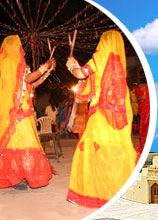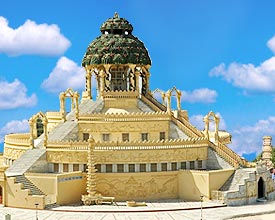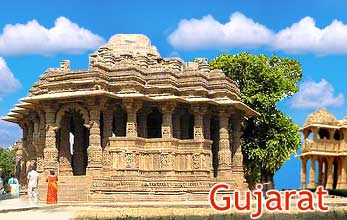 Gujarat
has a large flourishing textile industry which contributes to the arts
and crafts of India. The textiles have a large variety to offer to the
end consumers. It mainly depends on factors like varied raw materials,
combination of yarns and effective use of traditional techniques. The
enriched range of textiles owes to the people of different communities,
castes, tribes and regions of the state, who have kept the age old
tradition alive. For instance, Tangalia fabric from Surendranagar is
inlaid with thread during weaving, to create geometrical patterns and
peacock motifs. Deesa fabric was originally worn by tribes of Gujarat.
It contains geometric patterns with bold black outlines, in deep earthy
colors.
Gujarat
has a large flourishing textile industry which contributes to the arts
and crafts of India. The textiles have a large variety to offer to the
end consumers. It mainly depends on factors like varied raw materials,
combination of yarns and effective use of traditional techniques. The
enriched range of textiles owes to the people of different communities,
castes, tribes and regions of the state, who have kept the age old
tradition alive. For instance, Tangalia fabric from Surendranagar is
inlaid with thread during weaving, to create geometrical patterns and
peacock motifs. Deesa fabric was originally worn by tribes of Gujarat.
It contains geometric patterns with bold black outlines, in deep earthy
colors.Bandhani
Bandhani or Bandhej of Gujarat is one of the best tie and dye fabrics in India. These are produced on the mulmul (muslin) cloth, often combined with gold checks and motif work in the jamdani style. In this technique, a portion of the fabric is tied into tiny knots, following a pattern. Then, the fabric is dipped into a base color, followed by retying and dyeing. This is done several times till the final color scheme and pattern is achieved. Eventually, the complexity of the process and the quality of the fabric decides the price of a Bandhani piece. The main centers of Bandhani work in Gujarat are Kutch, Jamnagar and Saurashtra. You can also find Bandhani sarees, adorned with Zari work, in the markets of Jamnagar.
Dhamadka and Ajrakh
Dhamadka is the art of printing fabrics with wooden blocks. This is a major foreign exchange earner of the region, along with the modern screen printing art. The technique uses wooden blocks of around 1 ½ " to 3" thickness. The design to be printed on the fabric is first pin pricked on the wooden surface and later chiseled. After this, the blocks are dipped in different colors and stamped across the fabric. This leaves an imprint of the design of the block on the fabric. After printing, the fabric is fixed in river Gondali and spread to dry.
Dhamadka is widely practiced along the riverside town of Jetpur, midway Gondal and Junagadh. Its block prints are well known for the river water which brightens the colors of the fabric. Dhamadka block printing is available in a range of contrasting colors like maroons, yellows, blues and reds with patterns generated through tiny dots. Another popular area of printing is Kutch. Apart from block printing, artisans here also use vegetable dyes, paraffin wax resist and patricate-printing material. Though synthetic dyes and modern techniques have come up, bright Ajrakh prints are still in vogue.
Mashru
Mashru is a mixed fabric, woven with a combination of cotton and silk. It was originally used by Muslim men, as they were prohibited from wearing pure silk. This weaving technique was prevalent in Iraq and the Arab countries. This might have been the influencing factor for the rise of Mashru tradition in India. It was once woven in the whole country, but has now been confined to the state boundaries of Gujarat. Patan is one of the most important centers of Mashru weaving. It is practiced in different styles, like ikkat patterns in stripes, with extra warp threads, by the depression of the warp threads and even on a pit loom.









